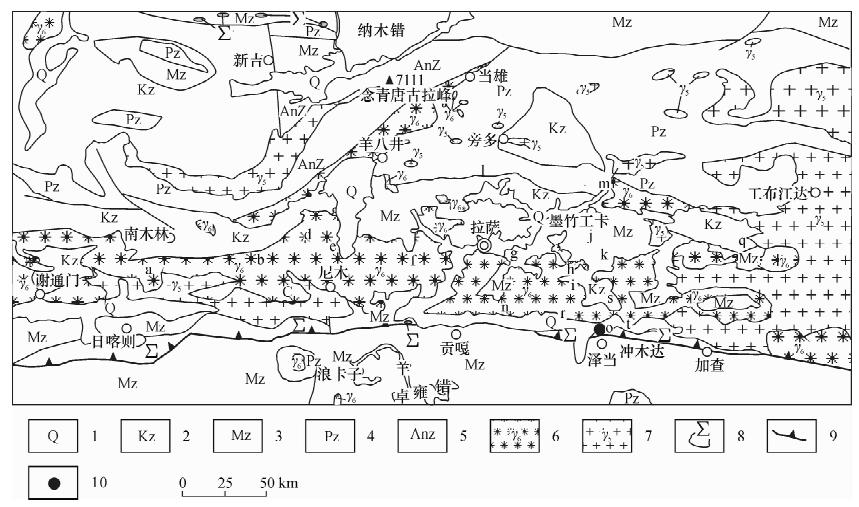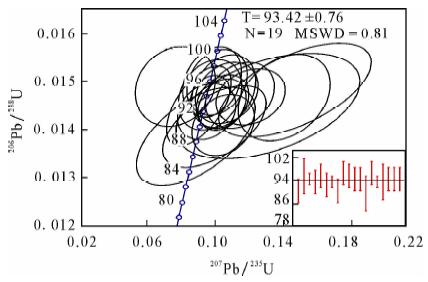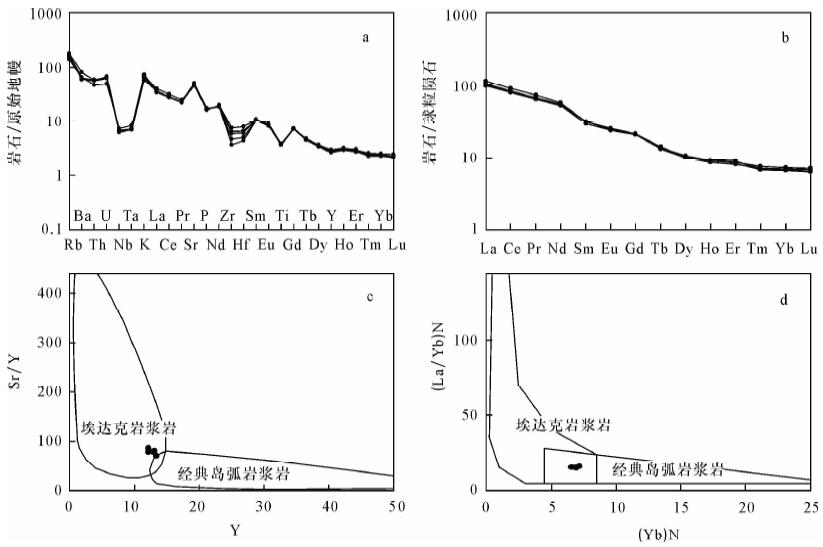LA-ICP-MS Zircon U-Pb Dating and Geochemistry of Late Cretaceous Quartz Diorite in the Nuri Cu-Mo-W Deposit, South Tibet
-
摘要: 藏南努日矿床位于冈底斯成矿带南缘, 前人获得的辉钼矿Re-Os同位素年龄为23 Ma, 与明则和程巴矿床成矿时代一致, 但矿区内至今未发现与矿化有关的成矿斑岩体。本文报道了努日矿区新发现的与矿化关系密切的石英闪长岩的地球化学特征, 获得石英闪长岩的LA-ICP-MS锆石U-Pb年龄为93.42±0.76 Ma, 与同一成矿带内桑布加拉和克鲁铜金矿成矿时代一致(90~93 Ma), 表明矿区可能存在两期成矿事件。石英闪长玢岩的主量微量元素SiO2含量为57.19%~58.23%, A12O3含量为15.78%~16.03%, MgO含量为4.74%~5.32%, Mg#指数为65.2~67.3;富集大离子亲石元素(Rb、Sr、Ba、U等)及轻稀土元素, 亏损高场强元素, 显示出埃达克岩特征。研究表明石英闪长玢岩形成于洋壳俯冲阶段的弧岩浆岩, 洋壳熔融形成的母岩浆侵入近地表形成早期铜多金属矽卡岩矿化。晚白垩世成矿事件的发现进一步佐证了研究区存在两期矿化叠加事件, 拓展了研究区找矿方向。
-
关键词:
- 藏南努日铜-钨-钼矿床 /
- 石英闪长岩 /
- LA-ICP-MS U-Pb定年 /
- 洋壳俯冲
Abstract: The Nuri deposit is located at the south margin of the Gangdese metallogenic belt in Tibet. Its mineralization age revealed by Re-Os dating of molybdenite is 23 Ma, which is consistent with that of the Mingze and Chengba deposits. However, the ore-related rocks have not yet been identified. In this study, we report the age and geochemistry of the newly discovered quartz diorite related to mineralization. LA-ICP-MS zircon U-Pb dating indicates that the diorite intruded at 93.42±0.76 Ma. The age is consistent with the ages of Shangbujiala(93 Ma) and Kelu(90 Ma) copper-gold deposits in the same metallogenic belt. These ages and previous ages indicate a two-stage ore-forming process. Major elemental analysis shows that quartz diorites contain 57.19%-58.23% SiO2, 15.78-16.03% A12O3, and 4.74%-5.32% MgO, with Mg# indicators of 65.2-67.3. Trace element composition suggests that these rocks are rich in large ion lithophile elements and light rare earth elements, but are poor in high field-strength elements, characteristic of adakite. This study indicates that quartz diorites are arc magmatic rocks formed in the stage of oceanic crust subduction. The primary magma formed by melting of oceanic crust intruded at the shallow crust, resulting in the formation of early skarn copper deposit. The identification of two stages of mineralization in the Nuri deposit expands the prospecting direction of the study area. -
西藏冈底斯成矿带是我国最为重要的铜多金属成矿带之一。冈底斯成矿带北部念青唐古拉弧背断隆带发育大量的矽卡岩型铅锌银多金属矿;中部以碰撞伸展阶段的斑岩型铜多金属矿为主[1];南部则发育矽卡岩型铜金矿和钨钼矿。一直以来,前人对北部铅锌成矿带和中部斑岩型铜多金属矿带的矿床地质、成矿年代学、地球化学等都进行了详细的研究[2, 3],然而对南部矽卡岩型铜多金属矿带研究十分薄弱。近年来在冈底斯南部成矿带新发现了一大批斑岩-矽卡岩型铜多金属矿,如程巴、克鲁、冲木达、桑布加拉、努日、洛村等铜多金属矿,对于这些矿床的成矿时代和成矿背景至今仍存在争议,程巴岩浆和成矿时代在30 Ma左右,桑布加拉岩体和成矿时代在93 Ma左右,而努日矿区存在多期次的岩浆活动,晚白垩世的岩浆活动至今还没有报道。
前人对努日矿区进行辉钼矿的Re-Os同位素定年的年龄结果为23.4 Ma,MSWD为0.6,可以代表矿区内最晚一期成矿作用[4]。本文对冈底斯南缘具有代表性和大型规模的努日铜-钨-钼金属矿矿床进行了详细研究,采集矿区南部的石英闪长岩进行锆石LA-ICP-MS定年研究和地球化学分析,探讨努日矿区铜多金属矿的多期叠加成矿作用,以进一步丰富该区域的找矿方向。
1. 研究区地质背景
西藏冈底斯成矿带,位于雅鲁藏布江弧陆碰撞结合带北侧的冈底斯火山-岩浆弧带内[5](图 1),潘桂棠等[6]将冈底斯及邻接区划分为班公湖—怒江缝合带等6个不同的构造单元,晚侏罗世—早白垩世桑日群以大量岛弧型钙碱性火山岩和弧缘碎屑岩、碳酸盐重力流沉积为特征。桑日群底部的麻木下组安山岩具有埃达克岩成分特征,上部的比马组具有正常岛弧火山岩特点[7]。
矿区地层主要为下白垩统比马组(K1b)、上白垩统—古近系旦师庭组(K2-E)d及第四系风成砂。比马组区域上可划分为5个岩性段[8, 9],矿区范围内仅出露3个岩性段分别为K1b3、K1b4和K1b5。K1b3岩性以泥晶灰岩、变质粉砂岩、砂岩为主;K1b4为矽卡岩型矿体的主要赋矿层位,岩性以大理岩及泥质灰岩为主,夹少量砂岩、凝灰岩,发育矽卡岩化;K1b5岩性以角岩化凝灰岩为主,夹安山质熔岩。矿区发育4组断裂构造,分别为NWW向F1断层、近EW向F2断层、NNW向F3断层及NE向F4断层。矿区岩浆岩岩性较复杂,出露面积较大,主要为始新世中酸性岩体以及本文新发现的晚白垩世石英闪长岩。努日铜-钨-钼矿主要产于比马组四段碳酸盐岩和碎屑岩的过渡地带,受地层岩性和层间剥离断层控制[10]。
2. 石英闪长岩样品采集和LA-ICP-MS分析
本文样品采自努日矿区南段与矽卡岩关系密切的石英闪长岩,石英闪长岩与矽卡岩接触部位存在矽卡岩化,风化后可见孔雀石充填于岩体裂隙中。锆石U-Pb定年以及主微量元素分析点均采集于离接触带较远的新鲜岩石样品。
石英闪长岩样品LB-5的LA-ICPMS锆石U-Pb测年在中国地质大学(武汉)地质过程与矿产资源国家重点实验室完成。首先,采用配备有阴极发光探头的JXA-8100进行阴极发光图像拍摄以揭示锆石内部结构。然后,进行LA-ICP-MS锆石U-Pb同位素分析,测试所用激光剥蚀系统为配备有193 nm ArF-excimer激光器的GeoLas 2005,激光斑束直径为30 μm。电感耦合等离子体质谱仪(ICP-MS)型号为Agilent 7500a(美国Agilent公司)。运用玻璃标准样品NIST610来计算Th、U含量,标准锆石91500对U、Th、Pb同位素分馏校正。数据处理采用ICPMS软件。锆石测试分析结果普通铅校正采用ComPbCorr#3.15,最后的数据用Isoplot 3.0进行计算。
石英闪长岩中的锆石无色透明,多为短柱状,部分颗粒有一定的磨圆,大部分锆石可见典型的韵律环带结构, 反映了岩浆成因的结构特点, 并且所有锆石均为原生岩浆锆石,不具有老核新壳的特征。锆石U-Pb共分析20个点,其中LB-5-14号点偏离谐和线较远,未参加加权平均计算(表 1),其余19个分析点的206Pb/238U-207Pb/238U年龄十分谐和,加权平均年龄为93.4±0.8 Ma(图 2),该年龄代表了石英闪长岩的侵入结晶年龄。
表 1 石英闪长岩锆石U-Pb同位素年龄分析结果Table 1. Zircon U-Pb isotope data of quartz diorite测量点号 Pb含量
(×10-6)Th含量
(×10-6)U含量
(×10-6)Th/U 207Pb/206Pb 207Pb/235U 206Pb/238U 207Pb/206Pb 207Pb/235U 206Pb/238U 比值 1σ 比值 1σ 比值 1σ 年龄
(Ma)1σ 年龄
(Ma)1σ 年龄
(Ma)1σ LB-5-01 2.65 121 134 0.902964 0.05248 0.00611 0.10171 0.01309 0.01406 0.00035 307 240 98 12 90 2 LB-5-02 1.94 77.5 92.9 0.833778 0.07416 0.00840 0.15157 0.01927 0.01482 0.0004 1046 225 143 17 95 3 LB-5-03 12.38 735 574 1.280539 0.04932 0.00239 0.09893 0.00495 0.01469 0.00018 163 105 96 5 94 1 LB-5-04 3.49 195 161 1.20958 0.04607 0.00359 0.09204 0.00821 0.01449 0.00034 2 152 89 8 93 2 LB-5-05 2.67 109 139 0.784713 0.03861 0.00495 0.07756 0.0101 0.0149 0.00034 -372 232 76 10 95 2 LB-5-06 5.58 372 251 1.484033 0.05125 0.00384 0.09678 0.00743 0.01437 0.00024 252 159 94 7 92 2 LB-5-07 6.17 423 272 1.556396 0.05429 0.00325 0.10662 0.0066 0.01458 0.00023 383 127 103 6 93 1 LB-5-08 4.08 176 214 0.824164 0.05688 0.00408 0.1071 0.00794 0.01409 0.00026 487 151 103 7 90 2 LB-5-09 4.03 180 203 0.884685 0.05066 0.00364 0.10033 0.00747 0.01499 0.0003 226 152 97 7 96 2 LB-5-10 5.37 249 264 0.94481 0.05502 0.00402 0.10741 0.00816 0.0148 0.00031 413 155 104 7 95 2 LB-5-11 3.70 144 197 0.731058 0.04936 0.00388 0.09898 0.00803 0.01472 0.0003 165 164 96 7 94 2 LB-5-12 4.11 172 214 0.805408 0.05894 0.00422 0.11755 0.00873 0.01471 0.00028 565 149 113 8 94 2 LB-5-13 2.39 118 111 1.066502 0.04717 0.00716 0.09009 0.01506 0.01385 0.00042 58 256 88 14 89 3 LB-5-14 4.09 140 134 1.050307 0.11557 0.01609 0.32843 0.05582 0.01662 0.00058 1889 257 288 43 106 4 LB-5-15 4.98 217 255 0.850507 0.05218 0.00371 0.10328 0.00758 0.01498 0.00028 293 152 100 7 96 2 LB-5-16 7.02 325 349 0.930867 0.05361 0.00295 0.10637 0.00608 0.01452 0.00022 355 118 103 6 93 1 LB-5-17 1.53 59.6 77.2 0.772481 0.06746 0.01083 0.13477 0.02322 0.01449 0.00045 852 330 128 21 93 3 LB-5-18 4.98 297 229 1.295082 0.06229 0.00426 0.12415 0.00873 0.01468 0.00024 684 139 119 8 94 2 LB-5-19 5.52 319 255 1.252934 0.05441 0.00382 0.10935 0.00791 0.01476 0.00026 388 150 105 7 94 2 LB-5-20 2.60 106 130 0.812055 0.07417 0.00567 0.14473 0.01164 0.01466 0.00037 1046 147 137 10 94 2 3. 石英闪长岩的主量和微量元素地球化学特征
努日石英闪长岩主量元素分析数据显示:SiO2含量为57.19%~58.23%,平均含量57.47%;A12O3含量为15.78%~16.03%,平均含量15.93%;Na2O含量为3.31%~3.56%,平均含量3.47%,K2O/Na2O比值较低(0.50~0.66,平均值0.57)。里特曼组合指数σ介于1.87~2.15之间,平均值2.06。MgO含量为4.74%~5.32%,平均含量5.09,Mg#指数为65.2~67.3,平均值66.2(表略),并含少量角闪石。这些数据表明石英闪长岩具有低硅、富钠、高镁特征,里特曼指数平均值小于3.3,属中基性钙碱性岩体。
微量元素分析表明:Sr含量为945~1056 μg/g,平均含量1001 μg/g;Y含量为12.2~13.5 μg/g,平均含量12.84 μg/g;Yb含量为1.12~1.23 μg/g,平均含量1.17 μg/g。微量元素蛛网图显示石英闪长岩富集大离子亲石元素(LILE)Rb、Sr、Ba、U等及轻稀土元素(LREEs),亏损高场强元素(HFSE)Nb、Ta、Zr、Hf、Ti等(图 3a),显示明显的俯冲消减带火成岩特征。稀土元素球粒陨石配分图显示石英闪长岩明显富集轻稀土元素(图 3b),具高的La/Yb值(20.51~22.03,平均值21.07),表明轻稀土元素强烈分异的端员。Eu*值为0.93~0.98,平均值0.95,有弱的负铕异常。另外,石英闪长岩具较高的Sr/Y值,在(Sr/Y)-Y及(La/Yb)N-YbN图中,样品全落入埃达克岩区域(图 3c, d)。
![]() 图 3 (a)努日石英闪长岩的原始地幔标准化微量元素蛛网图; (b)球粒陨石标准化稀土元素配分图; (c)~(d):(Sr/Y)-Y和(La/Yb)N-YbN判别图解(底图据Defant等[11]。Figure 3. (a) Primitive mantle normalized trace element spider diagram for the Nuri quartz diorite; (b) Chondrite-normalized rare earth element distribution pattern; (c)-(d) Diagrams of (Sr/Y)-Y and (La/Yb)N-YbN of Nuri quartz diorite (after Defant, et al[11].
图 3 (a)努日石英闪长岩的原始地幔标准化微量元素蛛网图; (b)球粒陨石标准化稀土元素配分图; (c)~(d):(Sr/Y)-Y和(La/Yb)N-YbN判别图解(底图据Defant等[11]。Figure 3. (a) Primitive mantle normalized trace element spider diagram for the Nuri quartz diorite; (b) Chondrite-normalized rare earth element distribution pattern; (c)-(d) Diagrams of (Sr/Y)-Y and (La/Yb)N-YbN of Nuri quartz diorite (after Defant, et al[11].以上主量和微量元素数据结果显示,石英闪长岩轻重稀土分馏较弱,稀土呈右倾模式特征,表明石英闪长岩具有弧岩浆岩特征,形成与新特提斯洋向北俯冲的弧环境。
4. 晚白垩世石英闪长岩构造背景和成矿作用讨论
4.1 构造背景
桑日群大量的岩石学、地球化学的研究表明其麻木下组火山岩均具有埃达克岩的特征[7, 12, 13, 14]。康志强等认为这些火山岩是洋壳初始俯冲的产物,其上部的比马组火山岩具有正常岛弧的特征[7],而在马门采取的酸性侵入岩(93.4 Ma)也具有埃达克岩的特征,是新特提斯洋平板俯冲的产物[15]。本次采集的石英闪长岩化学分析结果显示努日石英闪长岩地球化学特征与麻木下组火山岩的特征较为相似[7, 14],为俯冲阶段的产物,而MgO含量及Mg#值明显高于直接来自俯冲板片熔融形成的埃达克质熔体的MgO含量及Mg#值,说明岩浆在上升过程中与地幔楔发生反应,具有高镁特征。
对于与努日石英闪长岩同时代的马门侵入岩(93.4 Ma),马门侵入岩有更高的SiO2和全碱含量,而MgO(0.57%~0.63%)、Cr(11~12.3 μg/g)、Ni(3.37~4.85 μg/g)[15]明显偏低。董彦辉等[16]在分析叶巴组火山岩的过程中发现中基性火山岩与酸性火山岩具有不同的来源,其中,中基性岩是岩石圈地幔在热作用下或富流体作用下岩石圈发生部分熔融的产物;相反,酸性火山岩则是这次热事件引起的地壳深熔作用的产物。努日侵入岩为中酸性岩,是俯冲阶段的产物,且在岩浆上升过程中与地幔楔发生了反应。马门侵入岩为酸性岩,为加厚的下地壳受这次热事件引起的熔融作用的产物。
新特提斯洋自中生代开始向北俯冲,晚白垩早期仍然处于俯冲阶段,不可能是冈底斯地壳通过拆沉而形成,从空间上分析石英闪长岩与比马组呈侵入接触关系,其不可能是通过比马组玄武岩经过AFC过程形成。结合地球化学特征及其时间空间状态说明石英闪长岩是新特提斯洋壳向北俯冲消减发生部分熔融而成。张旗等[17]认为埃达克岩与成矿有着密切的关系,尤其是与板块俯冲有关的埃达克岩,目前已报道的与晚白垩纪早期有关的马门侵入岩具有埃达克岩特征[15]、桑布加拉铜矿形成与洋壳俯冲构造环境[16],努日石英闪长岩也具有埃达克岩特征,说明冈底斯存在一期俯冲阶段的成矿作用。2007年张宏飞等[18]在冈底斯识别出了一套90 Ma左右的花岗岩带。对于这个时代的成矿作用应该加强关注。
4.2 成矿作用
冈底斯南部铜矿及多金属矿同位素年龄大多小于41 Ma,然而,新特提斯洋自侏罗系就开始俯冲,在其俯冲过程中不断形成火成岩[16, 18, 19, 20],在长期的岩浆活动中是否存在与俯冲作用有关的矿床?藏南克鲁—冲木达铜金矿带上与努日铜金矿矿化密切相关的石英闪长岩锆石U-Pb年龄(93.42 Ma)大于碰撞期开始的时代65 Ma,说明在努日矿区93 Ma的石英闪长岩侵位后,与比马组灰岩发生了接触交代作用,形成了最早期的矽卡岩,对成矿元素进行了初步富集。另外在藏南克鲁—冲木达铜金矿带上,梁华英等[21]对桑布加拉矽卡岩型铜金矿的含矿岩体的U-Pb锆石定年获得了类似的结果年龄为92.1±1 Ma,也认为与洋壳俯冲构造岩浆事件有关,Jiang等[22]研究克鲁铜金矿发现,90 Ma埃达克质侵入岩与铜金矿有着密切的关系。所以冈底斯南部90 Ma的岩浆作用对矽卡岩型的铜多金属矿具有一定的贡献。
闫学义等[10]认为努日层矽卡岩铜钨钼矿年龄为40~68 Ma,而叠加的斑岩型矿床的形成阶段为23.62~30.26 Ma,矿区测试的辉钼矿Re-Os同位素等时线年龄为23.62±0.97 Ma。明则矿区也划分为早期层矽卡岩型铜矿和晚期隐爆角砾岩型钼矿、斑岩型钼(钨铜)矿,晚期斑岩型钼矿的Re-Os同位素等时线年龄为30.3±0.69 Ma[19]。另外,区域地球化学特征也显示Cu、Au和W、Mo并没有很好的套合趋势。由此可见:藏南矽卡岩型铜多金属矿和斑岩型及矽卡岩型钨钼矿存在两期或多期成矿作用,层状矽卡岩型铜金矿经历了晚白垩早期到古近纪—新近纪的多次叠加改造作用。而斑岩型钼矿主要为碰撞期形成,矽卡岩型铜钨钼矿为早期铜金矿叠加晚期钨钼矿而成。
5. 结论
努日矽卡岩铜-钨-钼矿床是冈底斯南缘首个大型铜钨钼矿床,因此详细研究矿区成岩成矿作用对于区域找矿工作具有标杆意义。本文在前人获得的成矿时代基础上新发现了一期与矿化关系密切的成矿岩体,研究结果表明,与矿化密切的石英闪长岩锆石LA-ICP-MS U-Pb年龄为93.4±0.8 Ma,与同一区域内桑布加拉和克鲁铜金矿成矿岩体年龄一致,明显早于矿区辉钼矿Re-Os年龄,岩石地球化学特征指示岩体具有高Sr低Y的埃达克岩特征,为洋壳俯冲熔融的产物。石英闪长岩的发现表明了努日矿区存在两期矿化叠加事件,早期成矿作用与新特提斯的俯冲有关,这一发现将有助于拓展冈底斯南缘的找矿方向。
致谢: 本文在野外工作中得到中国冶金总局第二地质勘查院西藏分院李秋平教授级高级工程师的支持和帮助,在文章撰写过程中成都地质调查中心王保弟研究员提供了宝贵的建议,在此对他们表示衷心的感谢。 -
图 3 (a)努日石英闪长岩的原始地幔标准化微量元素蛛网图; (b)球粒陨石标准化稀土元素配分图; (c)~(d):(Sr/Y)-Y和(La/Yb)N-YbN判别图解(底图据Defant等[11]。
Figure 3. (a) Primitive mantle normalized trace element spider diagram for the Nuri quartz diorite; (b) Chondrite-normalized rare earth element distribution pattern; (c)-(d) Diagrams of (Sr/Y)-Y and (La/Yb)N-YbN of Nuri quartz diorite (after Defant, et al[11].
表 1 石英闪长岩锆石U-Pb同位素年龄分析结果
Table 1 Zircon U-Pb isotope data of quartz diorite
测量点号 Pb含量
(×10-6)Th含量
(×10-6)U含量
(×10-6)Th/U 207Pb/206Pb 207Pb/235U 206Pb/238U 207Pb/206Pb 207Pb/235U 206Pb/238U 比值 1σ 比值 1σ 比值 1σ 年龄
(Ma)1σ 年龄
(Ma)1σ 年龄
(Ma)1σ LB-5-01 2.65 121 134 0.902964 0.05248 0.00611 0.10171 0.01309 0.01406 0.00035 307 240 98 12 90 2 LB-5-02 1.94 77.5 92.9 0.833778 0.07416 0.00840 0.15157 0.01927 0.01482 0.0004 1046 225 143 17 95 3 LB-5-03 12.38 735 574 1.280539 0.04932 0.00239 0.09893 0.00495 0.01469 0.00018 163 105 96 5 94 1 LB-5-04 3.49 195 161 1.20958 0.04607 0.00359 0.09204 0.00821 0.01449 0.00034 2 152 89 8 93 2 LB-5-05 2.67 109 139 0.784713 0.03861 0.00495 0.07756 0.0101 0.0149 0.00034 -372 232 76 10 95 2 LB-5-06 5.58 372 251 1.484033 0.05125 0.00384 0.09678 0.00743 0.01437 0.00024 252 159 94 7 92 2 LB-5-07 6.17 423 272 1.556396 0.05429 0.00325 0.10662 0.0066 0.01458 0.00023 383 127 103 6 93 1 LB-5-08 4.08 176 214 0.824164 0.05688 0.00408 0.1071 0.00794 0.01409 0.00026 487 151 103 7 90 2 LB-5-09 4.03 180 203 0.884685 0.05066 0.00364 0.10033 0.00747 0.01499 0.0003 226 152 97 7 96 2 LB-5-10 5.37 249 264 0.94481 0.05502 0.00402 0.10741 0.00816 0.0148 0.00031 413 155 104 7 95 2 LB-5-11 3.70 144 197 0.731058 0.04936 0.00388 0.09898 0.00803 0.01472 0.0003 165 164 96 7 94 2 LB-5-12 4.11 172 214 0.805408 0.05894 0.00422 0.11755 0.00873 0.01471 0.00028 565 149 113 8 94 2 LB-5-13 2.39 118 111 1.066502 0.04717 0.00716 0.09009 0.01506 0.01385 0.00042 58 256 88 14 89 3 LB-5-14 4.09 140 134 1.050307 0.11557 0.01609 0.32843 0.05582 0.01662 0.00058 1889 257 288 43 106 4 LB-5-15 4.98 217 255 0.850507 0.05218 0.00371 0.10328 0.00758 0.01498 0.00028 293 152 100 7 96 2 LB-5-16 7.02 325 349 0.930867 0.05361 0.00295 0.10637 0.00608 0.01452 0.00022 355 118 103 6 93 1 LB-5-17 1.53 59.6 77.2 0.772481 0.06746 0.01083 0.13477 0.02322 0.01449 0.00045 852 330 128 21 93 3 LB-5-18 4.98 297 229 1.295082 0.06229 0.00426 0.12415 0.00873 0.01468 0.00024 684 139 119 8 94 2 LB-5-19 5.52 319 255 1.252934 0.05441 0.00382 0.10935 0.00791 0.01476 0.00026 388 150 105 7 94 2 LB-5-20 2.60 106 130 0.812055 0.07417 0.00567 0.14473 0.01164 0.01466 0.00037 1046 147 137 10 94 2 -
-
期刊类型引用(6)
1. 侯德华,潘志龙,杨鑫朋,张立国,何娇月,张欢,程洲,王硕,王金贵. 西藏札佐晚白垩世中期埃达克岩年代学、地球化学及其构造意义. 沉积与特提斯地质. 2023(03): 592-603 .  百度学术
百度学术
2. 潘岚,谢伟. 藏南泽当努日铜钨钼矿床流体地球化学特征及矿床成因研究. 四川地质学报. 2023(04): 615-624 .  百度学术
百度学术
3. 闫国强,王欣欣,黄勇,李光明,刘洪,黄瀚霄,张志,田恩源,赖杨. Pb同位素对努日铜钼钨多金属矿床成矿物源的制约. 地球科学. 2020(01): 31-42 .  百度学术
百度学术
4. 张志平,钟康惠,董瀚,李鸿睿,汪宏涛. 西藏桑日县帕南岩体岩石学、地球化学、地质年代学研究及构造背景探讨. 沉积与特提斯地质. 2020(02): 52-64 .  百度学术
百度学术
5. 武雪梅,张志平,雒晓刚,周彦慧,刘晓涛,汪宏涛,王晓东. 西藏桑耶寺北岗结则雄花岗闪长岩体年代学、地球化学特征及地质意义. 矿产勘查. 2019(06): 1339-1350 .  百度学术
百度学术
6. 姚兴华,张志平,梁硕鹏,刘彩英,张晓娟. 西藏山南努日地区比马组火山岩地球化学特征及成因. 矿产勘查. 2019(09): 2119-2128 .  百度学术
百度学术
其他类型引用(4)




 下载:
下载:


 京公网安备 11010202008159号
京公网安备 11010202008159号